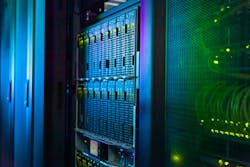AI, machine learning, the proliferation of cloud and high-performance computing and digitalization trends are driving the need for more data centers, IT infrastructure and communications technology. Powering next-generation IT equipment efficiently and effectively is a complex challenge, as evolving technologies demand higher energy densities and dynamic workloads continuously reshape power requirements for high-tech equipment racks. Strategic and innovative power management will be the cornerstone of scaling artificial intelligence and machine learning applications in 2025.
Meeting the Massive Power Demands of AI
As data centers continue to expand, data center managers need systems that not only deliver the right amount of electricity to power IT equipment but also prevent stranded power—making sure every watt is utilized effectively while remaining within the cooling system’s capacity to handle heat loads. By carefully managing power delivery, data centers can optimize energy efficiency, protect equipment, and avoid waste.
As racks become denser and AI workloads demand increasingly concentrated power, data center managers should expect growth in demand for high amp PDUs, which can safely deliver more power within racks to power next-generation equipment. At the same time, efficient cooling systems will be paramount to effectively manage heat loads and sustain equipment performance. Data center managers must proactively ensure uninterrupted operations, even during power outages. By leveraging DC power sharing features, one PDU can draw power from another to maintain uptime and provide personnel the crucial time needed to address issues and restore normal operations. Coupled with continuous monitoring systems, managers can stay informed in real-time so they are equipped to respond swiftly and effectively.
Retrofitting the Past, Powering the Future of AI
As demand for data skyrockets, the industry is racing to construct new data centers while breathing new life into existing ones. Older facilities often fall short of meeting the power demands of today’s AI and machine learning applications. To keep up, data center managers must reimagine their power infrastructure, investing in high-density, cyber-secure solutions that can handle the challenges of modern workloads.
To stay ahead, data center managers must prioritize partners capable of delivering on their promises while seeking products designed for seamless deployment. Innovations like color-coded rack PDUs simplify installation by enabling quick identification of primary and secondary power feeds, reducing downtime caused by human errors. Additionally, color coding for voltage, phase, or current ratings ensures safer and more efficient operations.
From Basic to Brilliant: The Growing Need for Smart PDUs
Basic PDUs power equipment effectively but lack advanced features for monitoring and control. Smart PDUs go a step further, integrating technologies to monitor power usage across multiple devices, provide proactive alerting and actively safeguard critical IT systems by detecting electrical and environmental risks.
The remote monitoring and control features of smart PDUs are game-changers in boosting energy efficiency and preventing downtime. Input metering allows operators to remotely track the electricity flowing into a PDU, reducing the chance of overloading and tripped breakers. By staying ahead of capacity limits, managers can mitigate risks before they escalate. High-accuracy metering provides real-time insights into power consumption, helping operators pinpoint inefficiencies and refine capacity planning.
Modern PDUs take monitoring to the next level by integrating outlet-level metering, offering advanced control and insights. This allows operators to track the energy consumption of each connected device, compare efficiencies and identify underutilized or “zombie” devices that waste power. By remotely addressing these inefficiencies, managers can optimize energy use. Advanced PDUs are also equipped with environmental sensors that help ensure critical IT systems remain protected from temperature and humidity risks.
Modern data centers demand tools that combine real-time monitoring with seamless maintenance. Remote alerts ensure potential issues are identified immediately, while hot-swappable controllers let teams address these challenges without shutting down critical systems. This combination keeps operations smooth and resilient.
Redefining Operations: Automation in Data Centers
In the years ahead, the focus for data center managers will shift toward achieving even greater precision in power control and monitoring. With richer data and improved analytics, managers will gain the tools to make smarter, data-driven decisions that optimize power use and efficiency.
As the data center industry evolves, the next leap forward lies in full automation of power and operations. Future data centers, whether newly built or retrofitted, will rely on automated processes to streamline efficiency, enhance reliability and elevate user experience. AI and machine learning will play pivotal roles, enabling smarter power management systems that are not only safer but also more efficient. To prepare for this future, here are some essential features data center managers should prioritize:
- Advanced networking capabilities
- Environmental monitoring paired with access control
- DC power sharing for redundancy
- Intuitive electronic color coding
- Toolless, hot-swappable components
- Precision high-accuracy metering
The power challenges of tomorrow’s data centers demand bold thinking and innovative solutions today. From smarter power distribution to full automation, the industry is set to redefine efficiency, reliability and sustainability. By embracing advanced tools and technologies, data center managers will not only meet the demands of AI-driven workloads but also unlock new levels of performance and scalability. The journey to the future of data center power management starts now.
About the Author

David Wood
David Wood is a Senior Product Manager – Edge Computing at nVent, where he leads nVent’s edge computing physical infrastructure solution business. David brings more than 25 years of experience in the exciting realms of technology, entrepreneurship and management including with a tech startup focused on delivering AI and Machine Learning magic to small and medium-sized businesses where he held a multi-functional role covering everything from strategy to customer service. He has also held product management and business roles at Legrand. David holds a patent for a Hybrid Transfer Switch used in datacenter infrastructure and has presented at industry events at Mission Critical Magazine, Data Center Frontier and Datacenter Dynamics.



